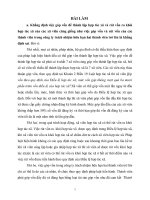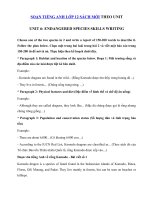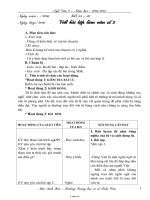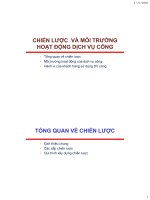Lei3025 assignment 2 individual consultancy report mai anh ngoc
Bạn đang xem bản rút gọn của tài liệu. Xem và tải ngay bản đầy đủ của tài liệu tại đây (92.34 KB, 11 trang )
ABSTRACT
Over the last two decades, the debate over customer satisfaction and service quality
have remained among tourism and hospitality research topics. Therefore, the current
study critiques service management and leadership principles and suggests a
combination of servant leadership style and customer orientation in hospitality
conduction. Some recommendations for human resource and marketing policies to
improve the quality of hospitality services are also proposed in the last section.
TABLE OF CONTENT
i
ABSTRACT..............................................................................................................i
TABLE OF CONTENTS........................................................................................ii
I. INTRODUCTION................................................................................................1
II. FINDING............................................................................................................2
2.1. Relevant theories relevant to service quality in the contemporary
hospitality industry.......................................................................................2
2.2. Critique the principles of hospitality service leadership.....................2
2.3. Different approaches to service management evaluation and realistic
recommendations..........................................................................................3
2.4. Researcher's argument..........................................................................4
2.5. Key issues that affect hospitality operations and solutions for service
improvement.................................................................................................5
III. CONCLUSION.................................................................................................6
References................................................................................................................8
ii
I. INTRODUCTION
Service quality and customer satisfaction have emerged as essential topics in
tourism and hospitality research that have gotten much attention from academics
and researchers. Since the initial models of service quality were published in the
mid-1980s, there have been many publications. Service quality is critical to a
company's profitability because it leads to repeat business and customer loyalty in
the long run (Rhoades, 2006). However, the approaches to investigating leadership
principles and service management did not dominate research on service quality and
customer satisfaction in the tourism and hospitality industry. As a result, these
factors remain a significant competitive advantage for tourism and hospitality
businesses. This research aims to examine management and leadership trends,
identify shortcomings, and make recommendations. The next section contains
reviews of the literature on hospitality service quality. It is then followed by
research on leadership principles and management approaches, which leads to an
argument for feasible hospitality management. The study also investigates critical
issues affecting hospitality operations and solutions to these issues before
concluding this paper.
1
II. FINDING
2.1. Relevant theories relevant to service quality in the contemporary
hospitality industry
The tourism industry is highly fragmented, with numerous sectors and sub-sectors
catering to visitors' needs. Visitors interact with various service providers, and the
interaction process and service delivery reflect critical attributes in the tourism
consumption process, such as value, quality, and satisfaction. In short, hospitality
service quality is an assessment drawn from the comparison between the quality
expected and the quality of the service received by the customer (Laws, 2001).
From the perspective of service consumers, hotel service quality is the level of
customer satisfaction.
Based on perception, the quality of hotel service is the customer's evaluation
drawn while "consumption" of the service; and based on experience, hotel service
quality is the customer's evaluation drawn after using and experiencing the services
provided by the hotel. From these criteria, this investigation studies the dependence
of hospitality product quality on leadership principles and service management
styles.
2.2. Critique the principles of hospitality service leadership
Popper (2005) stated three main leadership principles in the light industry:
democracy, transformational and servant leadership. Each principle has outstanding
features, but there are also specific limitations when applied to the hospitality
industry. While democracy is considered one of the most effective governance
trends, this method is not wholly perfect. Limitations of the democratic leadership
style in the hospitality industry include delayed decision-making, risk of poor
quality solutions and dissent. Where the team members' roles are not clearly defined
will cause delays in making decisions. At that time, gratis management can lead to
ineffective internal communication, affecting the ability to achieve the desired
goals. Also, disagreement is inevitable, leading to a decline in employee morale and
satisfaction.
Transformational leaders often focus on individual needs, leading to
employee burnout (Niemiec, 2020). Transformational leaders seek diversity because
more opinions and experiences lead to more innovation. Transformational leaders
encourage employees to seek opportunities to enhance their hospitality expertise to
foster diversity. The needs of individuals are often the focus of the leader rather
than the needs of the group as a whole, meaning that one team member tends to
receive more attention than others in the field. That leads to a lack of trust among
team members, ultimately affecting work productivity. However, if it is necessary
to maintain a high level of productivity for long periods, it can lead to employee
exhaustion.
According to Lacroix (2017), servant leaders can over-abdicate power and
fade into the woodwork in their attempt to "lead from behind," inadvertently
making their impact invisible to the organization. They may seek refuge in the
comfort of serving their employees, preferring not to engage higher up the chain
2
and thus failing to establish a strong presence with their leaders. All hospitality
organizations value servant leaders, but they also expect them to be highly
competent leaders in their field, with authority, control and the power to influence
in all directions (Cho, 2015). Furthermore, classic servant leaders frequently clash
with bosses who do not share the same leadership philosophies. Priorities, for
example, can quickly clash when the servant leader seeks to protect the people first
and the leader seeks to protect profit first. This disagreement can erode the servant
leader's trust in the eyes of their boss, making it harder for them to obtain the
resources and support they require to serve their constituents best.
2.3. Different approaches to service management evaluation and realistic
recommendations
According to Downar (2018), four critical aspects of the Service Management
perspective can be identified: the overall traditional perspective, customer focus,
quality focus & internal development and reinforcement. Traditional management
focuses more on cost-cutting efforts, specialization, and the division of labour,
which affects service quality, creates employee deterioration, jeopardizes external
affairs, and eventually declines profitability and customer fulfilment in the long run.
The hospitality industry can use software that supports technology and links the
business to the market to solve this problem. The use of technology in enterprise
production activities to increase efficiency and economy is becoming more
widespread, particularly in the problem of reception reservation and the accuracy of
business reports. In addition, hospitality businesses can collaborate with tour
companies and service quality review blogs.
Customer orientation is simply a business method or strategy in which a
company solves a problem for a customer at first. It is all about helping clients
achieve their goals, and the customer's needs are valued more than the needs of the
business. However, keeping up with market trends is difficult for new hospitality
businesses, especially the young generation, who change the demand to experience
fast over time (Anon, 2020). Therefore, in order to be able to orient the service
quality following customers, service providers should have surveys for popular
customer groups and continuously update changes in hospitality service trends
through social networks.
Quality management is clearly understood to be an essential component of
service management theory (Pizam, 2015). Researchers strongly advocate that the
customer determines what quality is and that customer-perceived quality should be
studied. Quickly responding to requests helps the hotel receive positive feedback
from guests. Long processing times for simple requests, such as when a guest
requests a blanket replacement or the remote control's battery is dead, can be
frustrating and lead to negative feedback about the hotel. The hotel will function
better and satisfy the guests if there is a team of trained staff focused on working
together to aid the guests, and the staff should be friendly and appropriate when
dealing with visitors' complaints.
The last approach-Internal focus discusses the compelling need to train and
develop employees while creating a commitment to the organizational objectives.
3
Hospitality providers should have a periodical test to assess the working capacity of
employees, thereby providing appropriate courses. When developing a training plan
for hotel staff, it is necessary to strictly comply with the standards of the service
industry to bring good training efficiency and help improve the hotel's service
quality.
2.4. Researcher's argument
Following some words on hospitality leadership principles and different approaches
to hospitality service management, it is clear that each principle or approach has
strengths and limitations. Since then, the writer provides various reasons in the
preceding paragraph why "Interaction between Servant leadership style and
customer orientation" will result in high efficiency in the hospitality industry.
Several studies on service leadership and its impact on staff mindset to
provide better service for organizations have been discovered. Baah-Mensah (2014)
contended that providing excellent service necessitates leaders believing in their
employees, coaching, teaching, inspiring, and listening to them. Hui (2015) then
reiterated that servant leaders enable employees to develop, trust, and gain
confidence, inspiring employees to interact effectively with customers. Service
leadership is associated with improved customer service by employees in the
hospitality industry. Designing a robust and quick service system capable of
responding to a service failure or crisis can ensure a good quality of service. Poor
service quality is frequently regarded as a systemic issue that affects not everyone
(Helms and Mayo, 2008). As a result, various practices and processes must be
blended into the service provider's service system to determine the remediation and
prevention of service failures. As a critical determinant of organizational
performance, any effective service system must proactively hinder and respond
effectively to service failures when they occur. Service leaders' vision is
communicated to employees by defining and communicating specific service goals.
Service failure prevention and recovery procedures should be chosen with the goals
and objectives identified in the organization's service manifesto. It assists in
establishing each employee's responsibility for the level provided to the client and
the satisfaction that should be developed for them among the services provided
(Sourdin, 2010). The more hotel employees are influenced by their leader to serve
others, the more likely they will prioritize their guests' needs over their own. It will
instil in the hotel staff a sense of urgency to respond or even avoid any customer
service error.
From January to December 2020, Kumar used an anonymous questionnaire
to collect data from employees working in 3 - 5 star hotels in Northern India. Seven
hotels were investigated, four of which were four stars and three five stars. Seven
hotel managers received 600 questionnaires, which were distributed to the
departmental managers in charge of these hotels. The majority (512/600) stated that
intellectual stimulation empowers employees and stimulates creativity in problemsolving while respecting new employee suggestions. The comments demonstrated
that the leader's concern is for each member's aspirations, needs, abilities, and
circumstances. All of the leaders interviewed support and agree with the research
hypotheses. This demonstrates that all aspects of the servant leadership style
4
positively impact employee customer orientation performance, and the knock-on
effect of managers' service leadership behaviour as a mediator of customer service
remains the primary contributor to the success of the customer-oriented approach.
Furthermore, the findings of this study lend support to the importance of hotel staff
in direct customer contact.
2.5. Key issues that affect hospitality operations and solutions for service
improvement
As according to Lawson and Wooliscroft (2004), the two most important
issues affecting hospitality operations are human resources and marketing policy.
Human creative labour is a decisive factor in business performance. The hotel needs
adequate investment to develop the retraining scale and train a team of intellectuals
and high-quality workers. In order to improve the existing shortcomings, the hotel
needs to develop a specific program and plan. Hotels can improve their staff's
foreign language skills and increase the bonus fund for employees. These solutions
encourage employees to find new customers and take advantage of their
relationships to introduce the hotel's services.
Self-sufficient travel has become a popular trend when customers are
increasingly active in finding information and booking rooms through online
platforms instead of using services at travel agencies (Seeman et al., 2019). So
tourist accommodation units, especially hotels, must know how to seize
opportunities and promote overall Online Marketing strategies to reach many target
customers. First, Websites are considered "faces" of the hotel on the Internet, which
customers will regularly visit and dig for information before deciding whether to
book. So investing in professional website design is always the ultimate marketing
solution for travel and hotel companies because customers often use travel
applications to book air tickets and hotel rooms. Second, linking with booking
applications allows hotels and travel businesses to display their services with all
images and information about prices, facilities and customer reviews. Along with
that, with the advantage of the number of users and the ability to reach and interact
well with customers, optimizing social networks is also a highly effective online
marketing solution.
5
III. CONCLUSION
At any time, improving business efficiency is an urgent requirement, a top
concern of every business. The article has raised several theories related to service
quality, thereby making objective comments on some hospitality principles and
management approaches. These assessments are the basis for the author to argue
that the combination of servant leadership style and customer orientation will bring
high efficiency in management and improve the quality of hospitality services. In
the end, this study discusses why human resources and marketing policy are critical
to a hotel's success and offers some recommendations relevant to the post-Covid
economic situation.
<2026 words>
6
7
References
Anon (2020) Predicting Customer Retention through Customer Orientation
of Service Employees: The Missing Link of Customer Satisfaction. JOURNAL OF
XI'AN UNIVERSITY OF ARCHITECTURE & TECHNOLOGY. XII(IV)
Baah-Mensah, S. (2014) Coaching for confidence. Nursing Standard. 29(5),
pp.26-27
Cho, E. (2015) Primary Identity of Missional Leaders: Servant Leader or
Leading Servant?. ACTS Theological Journal. 25, pp.95-122
Downar, W. (2018) Some aspects of trust in service activities. European
Journal of Service Management. 28, pp.79-85
Helms, M. and Mayo, D. (2008) Assessing poor quality service: perceptions
of customer service representatives. Managing Service Quality: An International
Journal. 18(6), pp.610-622
Hui, L., Mickleborough, N. and Chan, B. (2015) Service Leadership
Community: A seedbed for nurturing a service leadership mindset in engineering
student learning. QScience Proceedings. 2015(4), pp.18
Kumar, A., Mahajan, A. and Sharma, S. (2020) Sustainable Practices in
Hotels: A Study of Five Star Hotels in Northern India. SSRN Electronic Journal.
Lacroix, M. and Pircher Verdorfer, A. (2017) Can Servant Leaders Fuel the
Leadership Fire? The Relationship between Servant Leadership and Followers’
Leadership Avoidance. Administrative Sciences. 7(1), pp.6
Laws, E. (2001) Service Problems, Service Crises and Service Disasters.
Journal of Quality Assurance in Hospitality & Tourism. 2(1-2), pp.119-129
Niemiec, R. (2020) Transformational Leadership and Employee
Psychological Needs. INFLUENCE : International Journal of Science Review. 2(3),
pp.20-27
Pizam, A. (2015) Is empathy essential for high-quality customer service?.
International Journal of Hospitality Management. 49, pp.149-150
Rhoades, D. (2006) Growth, customer service and profitability Southwest
style. Managing Service Quality: An International Journal. 16(5), pp.538-547
Seeman, N., Goldfarb, D., Kuzan, E. and Seeman, M. (2019) Feasibility of
Obtaining Sufficient Numbers of Responses to Questions About Travel Intentions,
Thereby Facilitating Effective Health Messaging. International Journal of Travel
Medicine and Global Health. 7(2), pp.48-52
Sourdin, T. (2010) Poor Quality Mediation - A Systemic Failure?. SSRN
Electronic Journal.
8
9









